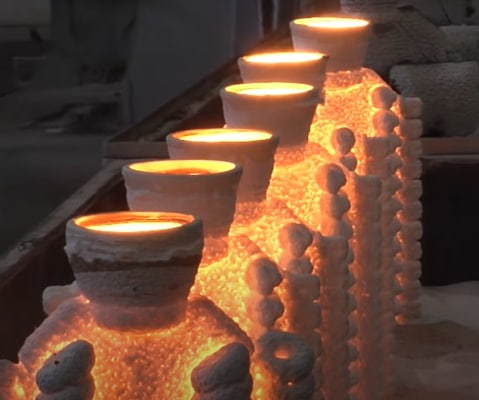Investment Casting Services
Get quality custom parts for prototyping and production, fast and cost-effective.
Investment Casting Materials
| Carbon Steel | Stainless Steel | Copper Alloy | Titanium Alloy | |
| A3 | D2 | 202 | C87500 | Ti-6Al-4V |
| 20 | A216 WCB | 303 | C87600 | Ti-6Al-2Sn-4Zr-2Mo |
| 45 | A216 WCA | 304 | C92600 | |
| 41402 | 1020 | 316/316L | C95500 | |
| 20CrMo | 1045 | 420 | C95400 | |
| 40CrMo | 1050 | 430 | C93200 | |
| 5Cr13 | ZG230-450 | |||
| 2Cr13 | ZG340-640 |
* We can source any other materials on request.
Investment Casting Finishes
Standard. With no secondary processing.
The bead blasting process shoots a blasting media – beads – under high pressure at a part to clean, polish, or roughen it to the desired finish.
A bead blast finish can clean a part’s surface, remove cosmetic defects, create a uniform surface with a dull, satin, or rough texture, and even harden a part’s surface and enhance its durability. It also prepares a part for paint and other coatings.
Bead media includes steel, glass, quartz sand, garnet, etc.
Manufacturers apply bead blasting for materials like metals, plastics, rubber, and glass.
Electrophoresis is the process of applying paint to parts by passing an electric current through the paint solution and parts immersed in it.
In many ways, this process is similar to electroplating. It is also called electrocoating, e-coating, electrophoretic coating, and electrophoretic painting.
Electrophoresis is suitable for aluminum alloy, zinc alloy, and stainless steel. It makes the parts present various colors and keep the metallic luster, and enhances the surface performance with high corrosion resistance.
Electroplating is the process of applying a thin layer of one metal to a part by passing a positively charged electrical current through a solution containing dissolved metal ions (anode) and a negatively charged electrical current through the part to be plated (cathode).
The aim is to improve the overall quality of the part. Some benefits include improving corrosion resistance, wear resistance, appearance, lubricity, and solderability.
Steels, nickel, copper-based alloys, and other metals are readily electroplated.
Polishing is the process of creating a shiny and smooth surface, either through physical rubbing of the part or by chemical interference.
The process enhances the aesthetic appeal, prevents corrosion, improves cleanability, and reduces adhesion of the parts.
It produces a surface with significant specular reflection but can reduce diffuse reflection in some materials.
Polishing works excellent with many metals, including aluminum, brass, stainless steel, and steel.
Powder coating is a process of applying a free-flowing, dry, thermoset, or thermoplastic powder to the surface of a part which is then cured under heat or with ultraviolet light.
The process creates a strong, wear- and corrosion-resistant layer that is more durable than standard painting methods.
It works perfectly on metals, plastics, and other materials.
Investment Casting Capabilities
| Metric | Imperial | |
| Max. Part Size | 600 x 600 x 150 mm | 23.62 x 23.62 x 5.91 in |
| Max. Part Weight | 60 kg | 132 lb |
Tolerances: VDG P690 D1-D2
What is Investment Casting?
Investment casting is a manufacturing process of complex parts by pouring melton metal into a ceramic mold.
A ceramic shell surrounds a wax pattern to form a ceramic mold. Once the ceramic shell is dry, the wax melts out, and the ceramic mold is formed.
Advantages of Investment Casting
Suited for highly intricate and complex metal parts
Exceptional surface quality
High dimensional accuracy
Allows for both large and small parts
Low tooling costs
Casting materials include virtually any alloy

Investment Casting FAQs
Investment casting is also known as “lost wax casting” because the wax around which the ceramic shell is formed is melted out, or lost, before the actual part is cast.
Investment casting is also known as “lost wax casting” because the wax around which the ceramic shell is formed is melted out, or lost, before the actual part is cast.
Investment casting is used to make near-net shape parts with superior finishes for applications in a wide range of industries, including oil & gas, medical & dental equipment, aerospace & aviation and military.
Most metals that can be melted and poured can be used for investment casting. The most common metals are stainless steel, nickel-based steel, cobalt-based alloys, brass, bronze, and copper.
Sand and investment casting have similar processes, but sand casting cannot always make small, intricate parts. Sand casting also often utilizes heavier weight limits, sometimes greater than a ton.

